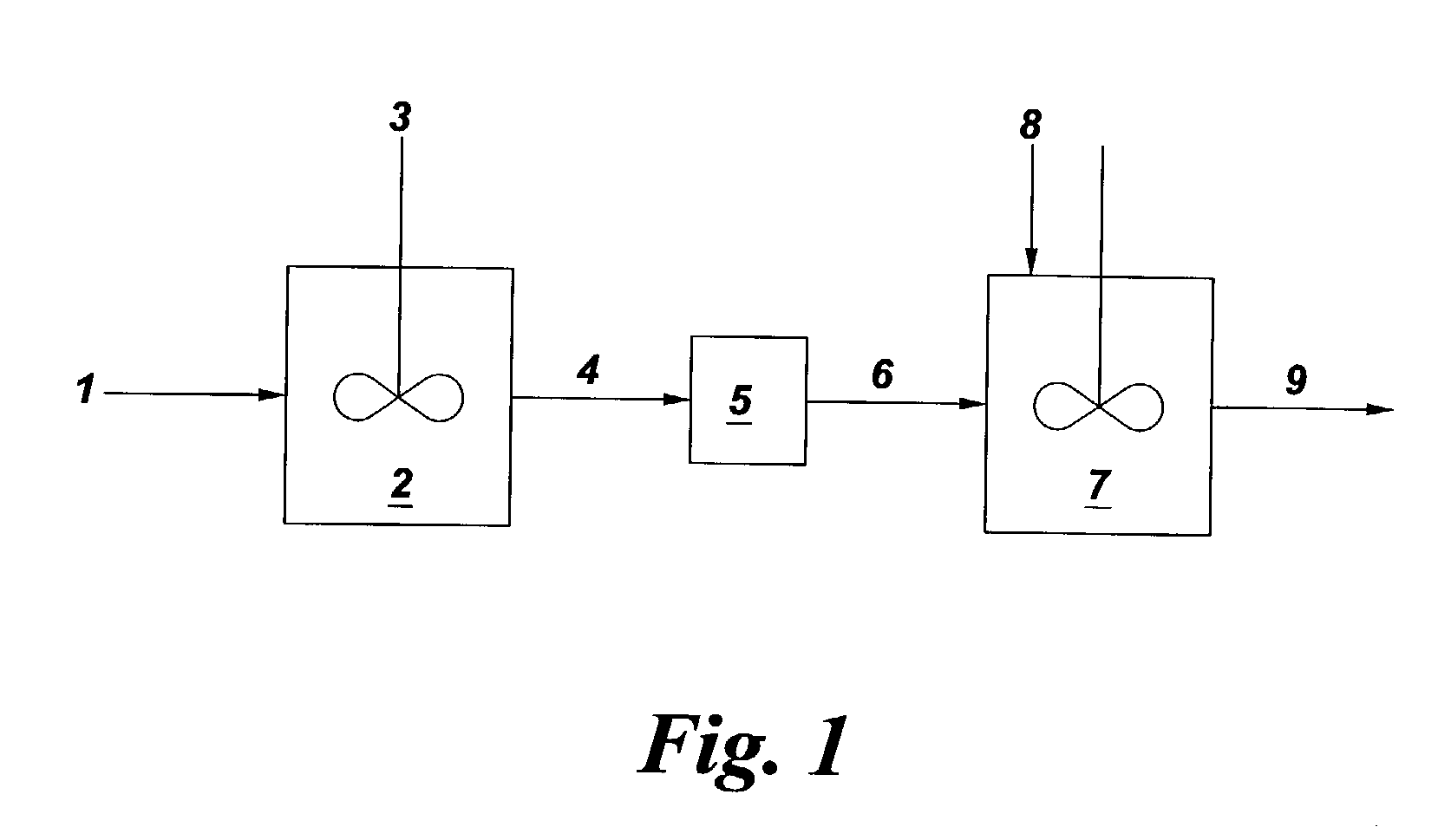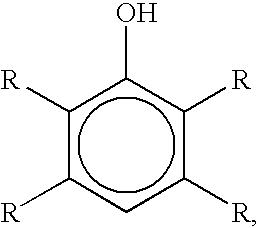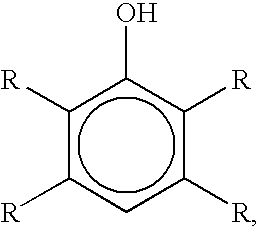Bromination of hydroxyaromatic compounds and further conversion to dihydroxyaromatic compounds
a technology of hydroxyaromatic compounds and dihydroxyaromatic compounds, which is applied in the field of reaction of hydroxyaromatic compounds, can solve the problems of inability to achieve the effect of hydrogen bromide alone, inability to commercialize bromophenols by reaction of phenols with hydrogen bromide or other simple ionic bromides, and inability to use a unitary set of equipment to produce two or more widely diverse products
- Summary
- Abstract
- Description
- Claims
- Application Information
AI Technical Summary
Benefits of technology
Problems solved by technology
Method used
Image
Examples
example 1
[0037]To a 3-dram vial were charged 1.37 ml (15.56 mmol) of phenol, 0.112 g (0.5 mmol) of cupric bromide, 1.39 ml (12.50 mmol) of 48% hydrobromic acid and 2.20 ml of acetonitrile. The vial was sealed with a cap containing a hole to allow for air flow during the reaction and placed in an aluminum block. The block was placed in a 450-ml autoclave reactor, pressurized to 34.0 atm with air and heated at 65° C. for 1 hour. It was then cooled to room temperature and depressurized. The resulting mixture was analyzed by vapor phase chromatographic analysis and shown to contain 7.39% phenol, 28.63% 4-bromophenol, 5.59% 2-bromophenol and 0.68% 2,4-dibromophenol, corresponding to 72% phenol conversion, with 82% 4-bromophenol selectivity and a total monobromophenol selectivity of 98%.
example 2
[0038]To a 3-dram vial were charged 1.59 ml (15.39 mmol) of o-cresol, 0.112 g (0.5 mmol) of cupric bromide, 1.48 ml (12.47 mmol) of 48% hydrobromic acid and 1.92 ml of acetonitrile. The vial was sealed and located as in Example 1, pressurized to 34.0 atm with air and heated at 65° C. for 1 hour. It was then cooled to room temperature and depressurized. The resulting mixture was analyzed by vapor phase chromatographic analysis and shown to contain 13.23% o-cresol, 27.74% 4-bromo-2-methylphenol and 0.93% 6-bromo-2-methylphenol, corresponding to 56% o-cresol conversion, with 96% 4-bromo-2-methylphenol selectivity and a total monobromophenol selectivity of 99%.
example 3
[0039]To a 3-dram vial were charged 1.37 ml (15.56 mmol) of phenol, 0.112 g (0.5 mmol) of cupric bromide, 1.30 ml (6.85 mmol) of a 30% solution of hydrogen bromide in acetic acid and 2.31 ml of acetonitrile. The vial was sealed and located as in Example 1, pressurized to 34.0 atm with air and heated at 65° C. for 1 hour. It was then cooled to room temperature and depressurized. The resulting mixture was analyzed by vapor phase chromatographic analysis and shown to contain 14.12% phenol, 19.15% 4-bromophenol and 1.15% 2-bromophenol, corresponding to 44% phenol conversion, with 96% 4-bromophenol selectivity and a total monobromophenol selectivity of 100%.
PUM
| Property | Measurement | Unit |
|---|---|---|
| temperature | aaaaa | aaaaa |
| pressure | aaaaa | aaaaa |
| temperature | aaaaa | aaaaa |
Abstract
Description
Claims
Application Information
 Login to View More
Login to View More - R&D
- Intellectual Property
- Life Sciences
- Materials
- Tech Scout
- Unparalleled Data Quality
- Higher Quality Content
- 60% Fewer Hallucinations
Browse by: Latest US Patents, China's latest patents, Technical Efficacy Thesaurus, Application Domain, Technology Topic, Popular Technical Reports.
© 2025 PatSnap. All rights reserved.Legal|Privacy policy|Modern Slavery Act Transparency Statement|Sitemap|About US| Contact US: help@patsnap.com



